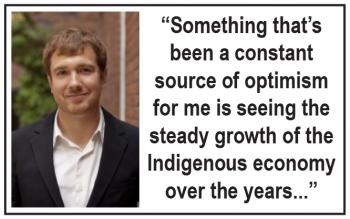Image Caption
Summary
Windspeaker.com Contributor
The newest report from the Canadian Council for Aboriginal Business highlights the importance of non-Indigenous business and governments collaboratively engaging with the economic and business development arms of Indigenous communities.
The first of a three-part series called National Perspectives on Indigenous Prosperity explores the capacity of Aboriginal Economic Development Corporations (AEDC). They invest in, own and/or manage subsidiary businesses with the goal of benefiting the Aboriginal peoples they represent.
An AEDC is community-owned, provides services both within and outside the community, and is a major source of employment within the Indigenous community. A percentage of any revenues goes into community development, such as health, education, social programs and infrastructure.
The National Perspectives on Indigenous Prosperity report was launched in Ottawa on Feb. 25 in a room full of government officials, Crown corporations, private corporations and large private businesses.
Of the 15 recommendations, the report calls on all stakeholders to “leverage the capacity of AEDCs to complete local and regional projects. The focal point of business arrangements with Indigenous communities should converge on sustainable partnerships instead of one-off contracts.”
Max Skudra, director of research and government relations with CCAB, isn’t concerned that the call for government and private corporations to do business with Indigenous communities is coming at a bad time, with Wet’suwet’en solidarity demonstrations cropping up across the country. The demonstrations have caused headaches for the Canadian economy with stoppages of rail traffic, and has side-tracked government agendas as people protest in support of Indigenous title rights and against a pipeline going through Wet’suwet’en territory.
“If anything the demonstrations are a signal of how important this collaboration really is,” said Skudra.
“I think given the long negative history from government, the fact that there are protests and demonstrations should surprise no one. And I think that this is just part of the road that we are all walking together and I think, if anything, this underscores how important this work really is,” he said.
Skudra points to the Procurement Strategy for Aboriginal Business program the federal government has had in place for the past 20 years. A target of five per cent procurement of supplies from Indigenous businesses has been set.
If the government met that target, it would mean an annual flow of $1 billion to Indigenous businesses, said Skudra. However, the government has never procured more than one per cent of its supplies from the Indigenous market.
Earlier this week, Skudra and Samantha Morton, CCAB’s project manager, met with government officials, including representatives from Finance and the department of Public Services and Procurement, to push that five per cent procurement target.
Prime Minister Justin Trudeau’s mandate letter to Public Services and Procurement Minister Anita Anand in December 2019 outlined the need for her department to “work with the Minister of Indigenous Services and the President of the Treasury Board to create more opportunities for Indigenous businesses to succeed and grow. The new target is to have at least five per cent of federal contracts awarded to businesses managed and led by Indigenous Peoples.”
Last December at the Assembly of First Nations’ Special Chiefs Assembly, Indigenous Services Canada Minister Marc Miller committed his department to delivering on the five per cent procurement promise and challenged other government departments to do the same.
“That’s really an opportunity for individuals, for entrepreneurs, for small business owners. As well, Indigenous businesses statistically are quite likely to hire Indigenous people so that also directly contributes to job security,” said Skudra.
On March 4, Canada’s Procurement Ombudsman will host the second Diversifying the Federal Supply Chain Summit in Toronto. The one-day summit is designed to increase awareness of the public and private sector programs that can help Indigenous peoples, as well as all gender identities, racialized people, persons with disabilities and minority groups access federal contracting opportunities.
Skudra, who has been doing research for CCAB for seven-and-a-half-years, says this study shows a growth in the relationship between AEDCs and private corporations. Where relationships began with the government-ordered duty to consult and then changed to impact benefit agreements, he now sees more collaboration and equal partnerships.
“Businesses and community development corporations start to work together to achieve positive outcomes they both see as important in terms of revenues or employment or specific infrastructure development,” he said.
That has resulted in an increase in the number of large Indigenous businesses that bring in $50 million to $100 million in annual revenue.
Skudra emphasizes that these Indigenous businesses have developed the capacity and professionalism to deliver on their contracts.
“Something that’s been a constant source of optimism for me is seeing the steady growth of the Indigenous economy over the years as we do this research,” he said.
CCAB will continue its work through its Procurement Champions program, which has 52 corporations tagged to increase organizational spending with Indigenous businesses, and meet with other corporations to get them on board.
This report was informed through in-person or telephone interviews with leadership from 49 AEDC in First Nations, Inuit and Metis communities across the country.
While the numbers of interviewees represent less than 10 per cent of all of Indigenous communities, Skudra is confident that by speaking with leaders nation-wide and those who live in rural, urban and remote communities, and pairing these findings with existing research undertaken by CCAB, that “50 was a very robust sample set given the purposes of this research (which) is to get a sense of what their vision for economic prosperity really is.”
AEDCs play an ever-increasing important role in driving the economy in Indigenous communities.
CCAB will be releasing two other reports in the next few months based on the interviews conducted. Community leaderships’ vision and goals for economic development will be the focus of one report, while the impact of economic development on social prosperity in Indigenous communities will be the focus of the other report.
The first report, Aboriginal Economic Development Corporations Capacity, can be accessed at https://www.ccab.com/research/national-perspectives-indigenous-economic-development/

